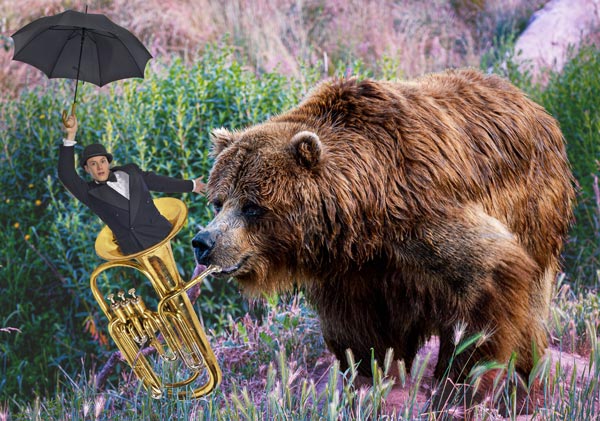Creating Surrealism in Photoshop
Ever since Salvador Dali mounted a lobster on a telephone in 1936, the public has taken surrealism to its heart. Unlike earlier art movements such as dada, cubism and futurism, surrealism is easy to grasp by even the least art-oriented viewer. It has an immediacy that bypasses the intellect and speaks directly to the subconscious.
Photoshop makes it easier than ever to create surrealist images, requiring just a modicum of photomontage skill to produce impressive results. What’s required here is imagination, more than technical capability; and with free scenes, people and objects readily available online, the only limits are your ability to make connections.
1. Surrealism by association
The easiest way to start is to take two objects that have a common thread, and combine them. Here I’ve used a cutout image of a shark, and a stock image of a swimmer.

The first step is to combine the two elements. I used Photoshop’s Puppet Warp controls to bend the shark to follow the angle of the swimmer’s body, then painted a Layer Mask on the shark to blend it into the body (left). I then added a layer mask to the swimmer as well, to hide her body parts that projected behind the shark (right).

The shark’s fins work well enough, but copying the swimmer’s arms to a new layer and moving them on top of the shark works better (left). Darkening the shark with the Curves adjustment enables it to blend in better with the body, more closely matching the shadows found there (right).

Placing the result on a background adds to the realism of the scene, which highlights the unreal nature of the composition and accentuates the danger of the shark in a supremely human environment. It really helps to make this a little more photorealistic: adding the shadow behind the swimmer places her more firmly into the new setting.

2. Surrealism by exaggeration
This stock image of a man lifting a woman in his arms might be used to advertise vacations, or house purchase, or anything from washing powder to shampoo. But with a little imagination, we’re able to change the emphasis significantly.

Swapping her head for a chicken, and his for a fox, brings an altogether different feel to the image. Rather than looking supportive, the man is now far more predatory. By swapping the heads we’re able to make a challenging statement about male-female relationships.

3. Surrealism by inference
This stock image of two men at a computer screen is bland, dull and very posed. But even the most antiseptic images can be used as the basis of something altogether stronger.

By changing the men’s heads for cameras, and placing a CCTV image on the screen, we’re able to make a point about surveillance culture. Adding an office background places the participants in a realistic environment; painting a dark vignette over the edges of the image helps to draw the viewer into the scene, and adds to the sense of conspiracy. Note that to add the camera to the figure on the right, you need to first remove the original head – and you can read how to do that here.

4. Surrealism by random association
As with Dali’s lobster phone, some of the most effective surreal images are created by linking two or more objects that have no connection with each other. Magritte’s The Key to Dreams is a prime example: a series of everyday objects is accompanied by a caption that seems to bear no relation to the object. By doing so, he forces you to think about both the object depicted and the one described in the caption in an entirely new way, devising relationships that might link the two.
In our final image, what’s the connection between a bear, a French horn and a man with an umbrella? The solution is entirely up to you. Even if it means nothing, it provokes the viewer to consider these elements in a different way. Even here, it helps to make the scene as realistic as possible: hiding the bottom of the French horn in the grass locates it in its environment.


